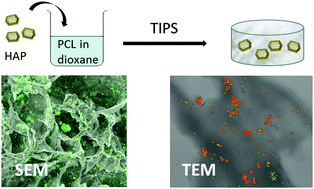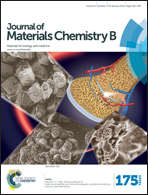Dispersion of hydroxyapatite nanoparticles in solution and in polycaprolactone composite scaffolds†
Abstract
The dispersion behaviour of hydroxyapatite nanoparticles (HAP) and surface-modified HAP was studied in 1,4-dioxane (DO), water and poly(ε-caprolactone) (PCL) solutions and the relationship between these and the dispersion in composite PCL scaffolds prepared by thermally induced phase separation (TIPS) was examined. Investigation of the change in particle sizes by dynamic light scattering, showed that the modification of HAP by adsorption or covalent attachment of heparin via a 3-aminopropyltriethoxysilane (APTES) layer improved the dispersion stability of the particles in water/DO mixtures, while no improvement was observed in DO. The distribution of the particles within the composite scaffolds was determined using a combination of transmission electron microscopy and a calcium quantification method which was used to determine distribution of the particles in the vertical direction. While the scaffolds fabricated in DO had particles embedded within the walls of the scaffold, the scaffolds fabricated in a DO/water mixed solvent showed the particles partitioned to the surface of the scaffold walls, which is likely because the particles acted as interface stabilisers and were not miscible with the PCL rich phase. Therefore, it can be concluded that the polymer–solvent system used, as well as the phase separation mechanism that occurs, significantly influences the distribution of the particles in the scaffolds and thus the particle behaviour in solution is not necessarily a good predictor for the ability to fabricate scaffolds with a high degree of particle dispersion and hence for overall materials performance. Bulk crystallinity and compressive modulus were examined and it was determined that no significant changes occurred compared with the pristine PCL, while the surface bioactivity of the scaffolds had improved significantly, indicating that the particles were present at the polymer–solution interface.


 Please wait while we load your content...
Please wait while we load your content...